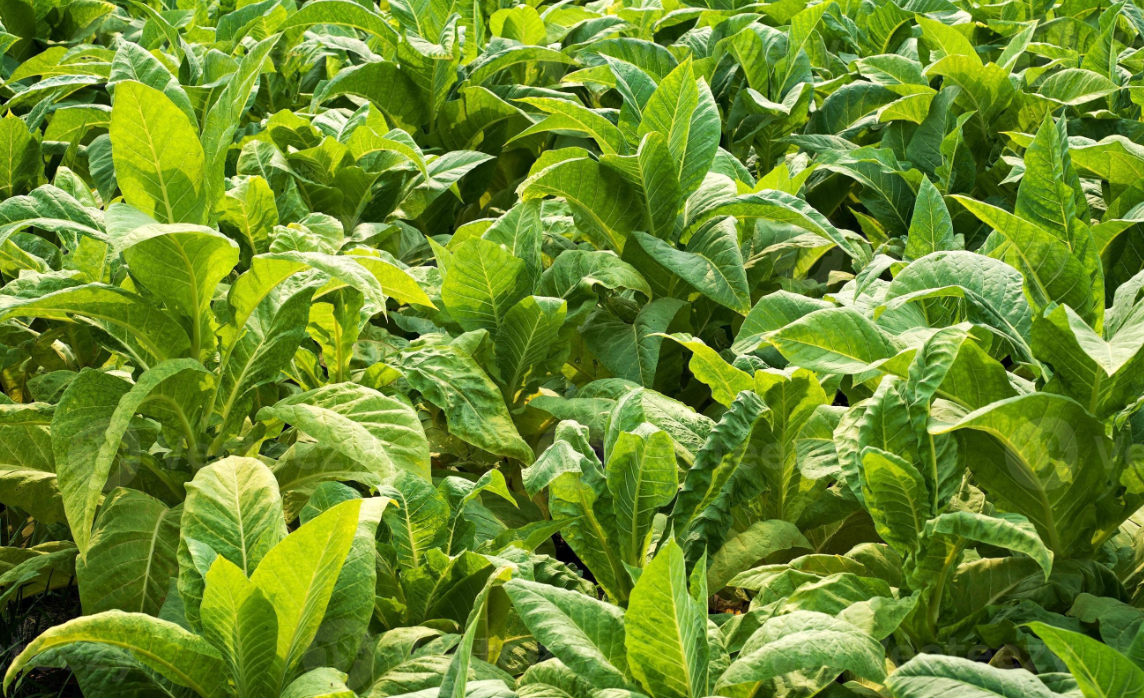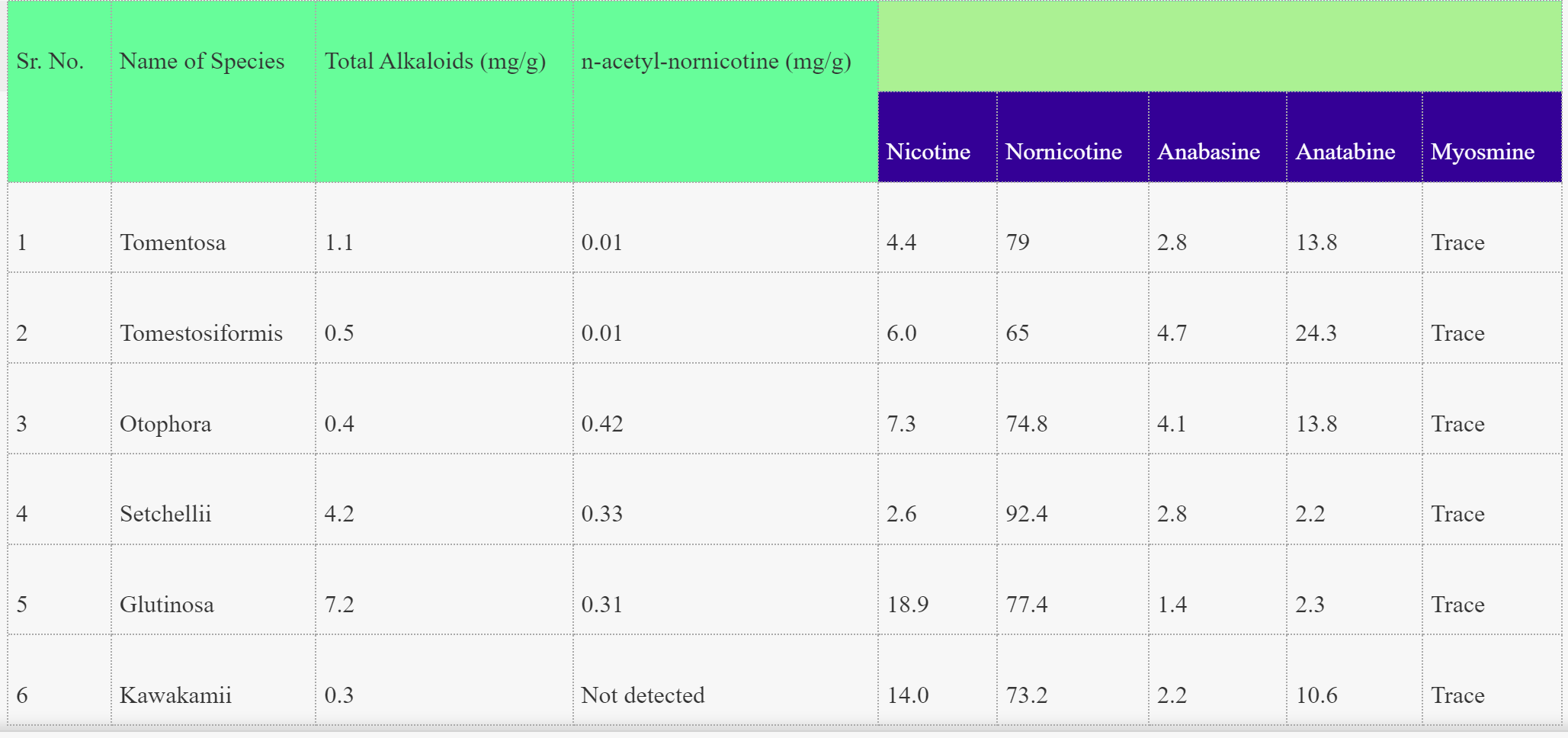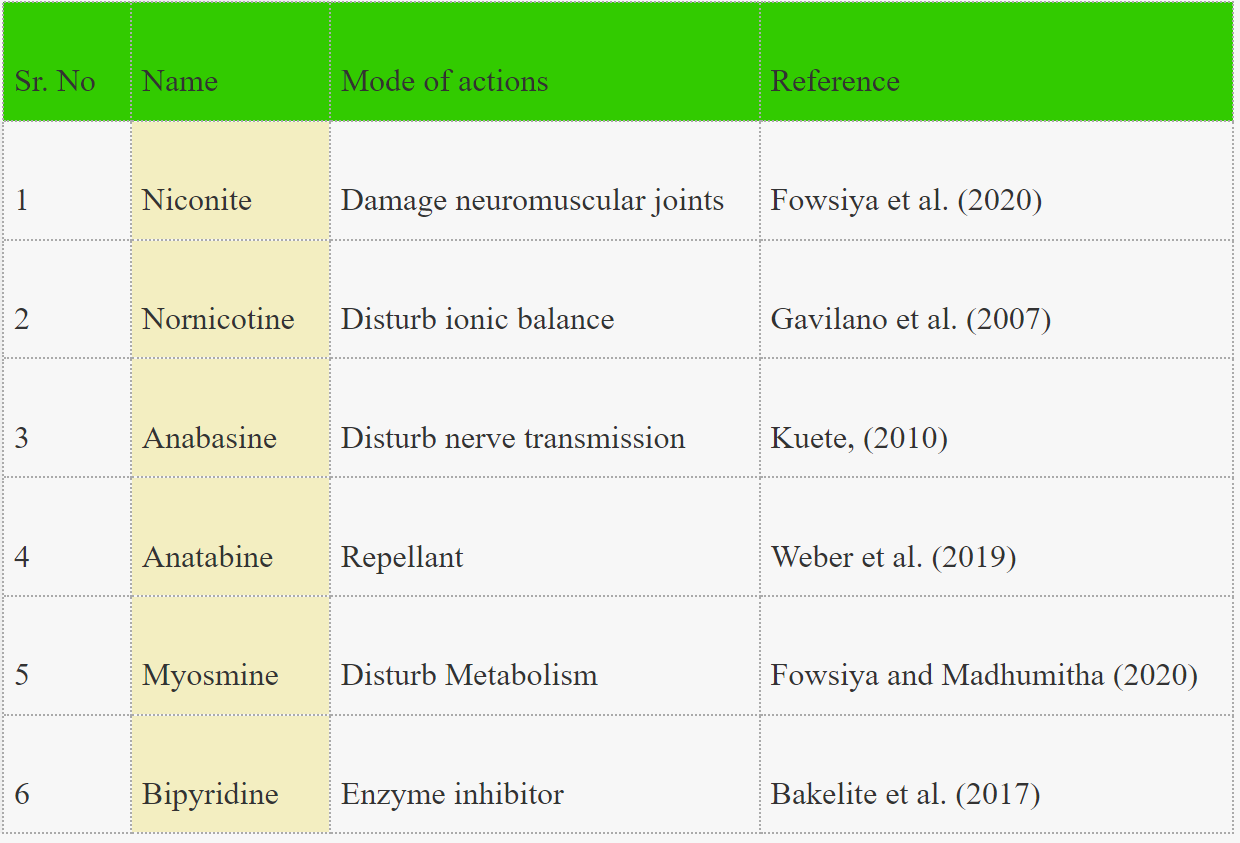Insecticidal Properties of Tobacco Leaves for Organic Farming: A Short Review
By
Saqib Ali Ateel
&
Salman Ahmad
Ph.D. Agronomy
Tobacco is one of the famous botanicals. Tobacco leaves extract is being used to control agricultural pests in different countries for centuries. Around the 1st century BC, it was famous for its medicinal properties and was used to cure certain illnesses like sore eyes, bowel problems, insect bites and burns. The tobacco plant is native to northern America. It has wide adaptability and can be grown on plain land, wetlands, forest and mountains.

Tobacco leaves naturally contain many chemicals having insecticidal properties (table 1 & 2). Tobacco was first used as an insecticide in 1690 against the pear-lace bug. In the late seventeenth and early eighteen centuries, it was used as an insecticide in England and America against different aphid species, red spiders and lice. The main pesticidal compounds in tobacco are nicotine, nor-nicotine and anabasine. Nicotine can be synthesized artificially, but natural products are far cheaper and preferred. Tobacco leaves contain about 3% nicotine on a dry matter basis which is the main insecticidal constituent of tobacco. In the beginning, tobacco was used as a fumigant to control pests, but due to rapid dermal absorption of nicotine by mammals and health issues, it is now used in an aqueous solution form.
Table 1: Chemical Composition of Tobacco Leaves’ Extract of Different Tobacco Species

Source:
Sissor and Severson, (1990)
Table 2: Mode of Action of Different Pesticidal Compounds Found in Tobacco Leaf Extract

Scientific evidence of pesticidal effects of tobacco
Rajpoot et al. (2017) tested different biopesticides against pink cotton bollworm and found a significant effect of tobacco leaf extract against larva of pink bollworm on both Bt and non-Bt cotton.
Baskaran and Narayanasamy (1995) reported that the aqueous extract of tobacco leaves significantly affects aphids, thrips, and beetles.
Amoabeng et al. (2013) prepared tobacco leaf extract in water containing 0.1% detergent and sprayed it against a diamondback moth in a cabbage field. The results were surprisingly interesting. Tobacco extract resulted in a 93% reduction in larval population while synthetic pesticide (cyhalothrin) used resulted in only 51% control on larvae of diamondback moth population.
Tobacco extract is highly effective against peach moths (98%) and twig borer (99%), as reported by Trandafirescu et al. (2013).
Kawuki et al. (2005) found excellent results of tobacco crude extract on bruchid beetle (up to 90%) in Uganda.
Ogbalu et al. (2014) found significant mortality of housefly larvae within 48 hours after spraying of aqueous extract of tobacco leaves @ 3ug/ml concentration.
Patel et al. (1990) reported that nicotine sulphate isolated from tobacco leaf extract was a toxin to aphids and gave significant control on aphids.
In 2002 a lectin named NICTABA was discovered in tobacco leaves which is highly effective against lepidopteran insect larvae.
Wuryantini et al. (2021) prepared tobacco extract in methanol and found it very effective against citrus psyllids and aphids. Even the efficacy of tobacco extract was more than synthetic pesticides (dimethoate and imidacloprid).
Potera (2013) documented that tobacco bio-oil (leaf extract in water) 100% killed the Colorado beetle of potato. Besides this, it also significantly blocked the growth of bacteria and fungus responsible for potato scab disease. Similar effects were also found in pepper, tomato, eggplant and lettuce.
Suggestions to Use Tobacco Leaves
Tobacco is a toxin to birds and other friendly insects (honey bees, ladybird beetle, etc.). So, its dose should be suggested keeping in view the crop type and types of friend insects.
Different environmental variables, especially temperature, on tobacco biopesticide efficacy should be studied.
The efficacy of tobacco solutions in different solvents (alcohol, ether, ethanol) should also be investigated.
Residual effects of biopesticides, especially on edible crops, must be explored.
- Home
- Organic Farming
- Tobacco Leaves
Express Your Opinion
We find value in differences between learning, interpreting and overall opinions. Please share your thoughts freely about this topic, but always remain respectful. You can preview and edit on the next page before your submission is sent in. You will also be informed about this site's privacy policies. Thank you for your contribution.
References
Amoabeng BW, Gurr GM, Gitau CW, Nicol HI, Munyakazi L, Stevenson PC. Tri-trophic insecticidal effects of African plants against cabbage pests. PloS One. 2013; 8: e78651. https://doi.org/10.1371/journal.pone.0078651 PMID: 24205287
Bakhite, E. A., Abd-Ella, A. A., El-Sayed, M. E., & Abdel-Raheem, S. A. (2017). Pyridine derivatives as insecticides. Part 2: Synthesis of some piperidinium and morpholinium cyanopyridinethiolates and their Insecticidal Activity. Journal of Saudi Chemical Society, 21(1), 95-104.
Fowsiya, J., & Madhumitha, G. (2020). A Review of Bioinsecticidal Activity and Mode of Action of Plant Derived Alkaloids. Research Journal of Pharmacy and Technology, 13(2), 963-973.
Fowsiya, J., & Madhumitha, G. (2020). A Review of Bioinsecticidal Activity and Mode of Action of Plant Derived Alkaloids. Research Journal of Pharmacy and Technology, 13(2), 963-973.
Gavilano, L. B., Coleman, N. P., Bowen, S. W., & Siminszky, B. (2007). Functional analysis of nicotine demethylase genes reveals insights into the evolution of modern tobacco. Journal of Biological Chemistry, 282(1), 249-256.
Goodman, J. (2005). Tobacco in history: The cultures of dependence. Routledge.Baskaran V, Narayanasamy P. Traditional Pest Control. Caterpillar Publications. Mariyappa Nagar, Tamilnadu, India. 1995; p.91.
Kawuki R, Agona A, Nampala P, Adipala E. A comparison of the effectiveness of plant-based and synthetic insecticides in the field management of pod and storage pests of cowpea. Crop Protect. 2005; 24: 473±478.
Kuete, V. (2014). Health effects of alkaloids from African medicinal plants. In Toxicological survey of African medicinal plants (pp. 611-633). Elsevier.
Ogbalu, O.K., Bobmanuel, R.B., Membere, O., 2014. Larvicidal effect of aqueous leaf
Potera, C. (2011). INNOVATIVE TECHNOLOGIES: Tobacco Bio-oil Kills Agricultural Pests.
Prakash, A., Rao, J., & Nandagopal, V. (2008). Future of botanical pesticides in rice, wheat, pulses and vegetables pest management. Journal of Biopesticides, 1(2), 154-169.
Rajput, I. A., Syed, T. S., Abro, G. H., Khatri, I., & Lodhi, A. M. (2017). Effect of different plant extracts against pink bollworm, Pectinophora gossypiella (Saund.) larvae on Bt. and non-Bt. cotton. Pakistan Journal of Agricultural Research, 30(4).
Sisson, V. A., & Severson, R. F. (1990). Alkaloid composition of the Nicotiana species. Beiträge zur Tabakforschung International/Contributions to Tobacco Research, 14(6), 327-339.
Weber, S. S., Kaminski, K. P., Perret, J. L., Leroy, P., Mazurov, A., Peitsch, M. C., ... & Hoeng, J. (2019). Antiparasitic properties of leaf extracts derived from selected Nicotiana species and Nicotiana tabacum varieties. Food and Chemical Toxicology, 132, 110660.
Wuryantini, S., Endarto, O., Wicaksono, R. C., & Yudistira, R. A. (2021, May). Utilization of plant waste as a botanical pesticide for citrus pest control. In IOP Conference Series: Earth and Environmental Science (Vol. 749, No. 1, p. 012022). IOP Publishing.
Potera C. (2011). Tobacco bio-oil kills agricultural pests. Environmental health perspectives, 119(1), A18. https://doi.org/10.1289/ehp.119-a18a
- Home
- Organic Farming
- Tobacco Leaves
What are iron fortified foods?
- Home
- Organic Farming
- Tobacco Leaves
What's New?
-
What are iron fortified foods?
Iron fortified foods contain additional iron to help prevent deficiencies and support overall health, particularly in children and pregnant women. -
What are fortified foods?
What are fortified foods? How are they different from staple and common everyday foods? -
Baby Organic Food: “To be, or not to be, that is the question”
Baby organic food is free from insecticides, weedicides and residues of synthetic fertilizers thus much safer for babies

DOWNLOAD!



